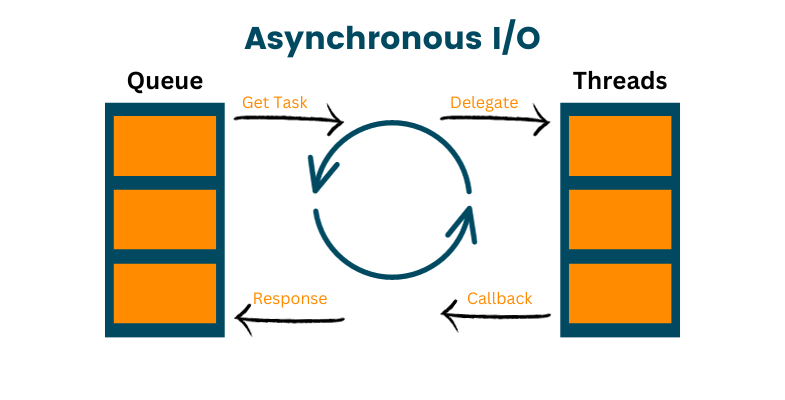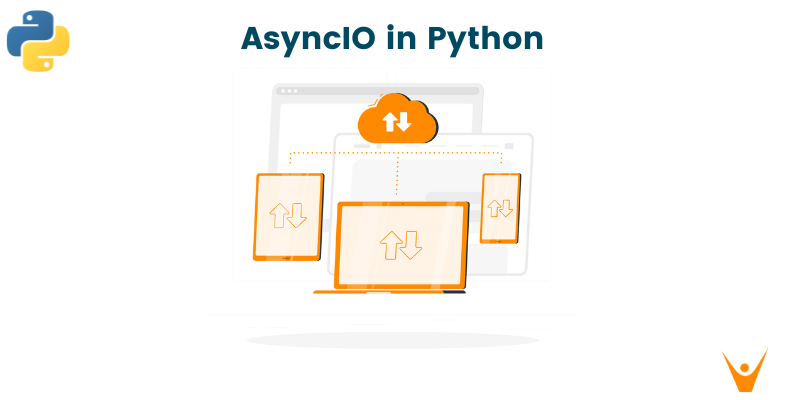Python, a widely adopted programming language, has adapted to this paradigm shift by introducing asyncio, a robust library for asynchronous programming. In this article, we will embark on an extensive exploration of the realm of asyncio in Python. We will not only delve into its various applications but also offer practical examples, examine its strengths, and tackle some of the criticisms it has garnered. Additionally, we will briefly discuss alternative solutions and clarify its position within the Python standard library.
What is Python Asyncio?
Asyncio, which is short for "asynchronous I/O," emerged as a Python library with the release of Python 3.3. Its primary objective is to empower developers to create asynchronous, non-blocking code. This is achieved by offering a set of tools and leveraging the async/await syntax. Asyncio streamlines the process of building asynchronous applications by furnishing a structured framework for handling concurrent I/O-bound tasks, including but not limited to operations like network requests and file I/O.
What is Asynchronous Programming in Python?
Before we plunge into the intricacies of asyncio, it's essential to grasp the concept of asynchronous programming in Python.
In traditional synchronous Python code, execution proceeds sequentially, with each line blocking the program until a task finishes. This can result in performance limitations, particularly when dealing with time-consuming I/O-bound operations.
On the contrary, asynchronous programming enables tasks to run concurrently, without hindering one another. This is made possible by employing coroutines and event loops.
What is Python Async Library?
Asyncio provides a set of abstractions and functions to help developers write asynchronous code more easily. It includes asynchronous versions of common Python modules, such as asyncio.FileIO, asyncio.subprocess, and asyncio.Socket, making it straightforward to work with asynchronous I/O operations.
One of the core features of asyncio is the event loop, which is responsible for scheduling and managing asynchronous tasks. The event loop is at the heart of asyncio, ensuring that coroutines and callbacks execute efficiently.
Python Asyncio Example
Let's take a look at a straightforward Python asyncio example to demonstrate its practical application. Imagine you need to perform multiple HTTP requests concurrently, all while avoiding the blocking of other tasks. Here's a concise illustration of how you can accomplish this with asyncio:
import asyncio import aiohttp async def fetch_url(url): async with aiohttp.ClientSession() as session: async with session.get(url) as response: return await response.text() async def main(): urls = [ 'https://example.com', 'https://openai.com', 'https://github.com' ] tasks = [fetch_url(url) for url in urls] responses = await asyncio.gather(*tasks) for url, response in zip(urls, responses): print(f"URL: {url}, Length: {len(response)}") if __name__ == '__main__': asyncio.run(main())
In this example, we used the aiohttp library to perform asynchronous HTTP requests. We define a coroutine fetch_url to make the requests and use asyncio.gather to execute them concurrently. The program doesn't block, and all responses are collected efficiently.
Why Use Asyncio in Python?
Now that you've seen an asyncio example, let's explore why you might want to use asyncio in your Python projects.

1. Improved Performance
Asyncio shines in scenarios where multiple I/O-bound tasks need to be executed concurrently. It reduces the time your program spends waiting for I/O operations to complete, leading to significantly improved performance.
2. Scalability
Asynchronous programming is well-suited for building scalable server applications. It enables a single server to handle a large number of clients concurrently, making it ideal for building networking services like chat servers, web servers, and more.
3. Non-blocking User Interfaces
For applications with graphical user interfaces (GUI), asyncio helps keep the interface responsive while performing time-consuming tasks in the background. This ensures a smoother user experience.
4. Handling Many Connections
Asyncio is excellent for handling a large number of concurrent connections, making it a great choice for building chat applications, real-time systems, and web scraping tools.
5. Cooperative Multitasking
Asyncio facilitates cooperative multitasking, where tasks yield control to the event loop voluntarily. This cooperative approach ensures that the application remains responsive.
Drawbacks of Asyncio in Python
While asyncio is a valuable addition to Python, it's not without its criticisms. Let's explore some of the common drawbacks:
1.More Complex
Asynchronous programming can be more complex to write and debug than synchronous code. Managing event loops, handling exceptions, and avoiding race conditions can be challenging for developers, especially those new to asyncio.
2. Limited CPU-bound Performance
Asyncio is primarily designed for I/O-bound operations. It may not be the best choice for CPU-bound tasks, as it doesn't provide true parallel execution. For CPU-bound tasks, Python's Global Interpreter Lock (GIL) can limit performance gains.
3. Learning Curve
Developers accustomed to synchronous programming may find the transition to asynchronous code challenging. It requires a different mindset and can be intimidating for newcomers.
4. Lack of Built-in Networking Protocol Support
While asyncio provides the tools to create network clients and servers, it doesn't include built-in networking protocols like HTTP. You often need to rely on third-party libraries for protocol support.
Is Asyncio Part of the Python Standard Library?
Indeed, asyncio is an integral component of the Python standard library. It made its debut in Python 3.3 and has since matured and expanded with subsequent Python releases. This signifies that you do not need to install any external packages or libraries to access and employ asyncio; it comes pre-packaged with your Python installation, making it accessible and convenient for developers.
Conclusion
Asyncio is a valuable addition to Python for building asynchronous applications. It provides the tools and abstractions necessary to write non-blocking, concurrent code, improving performance and scalability. While it has its criticisms and may not be suitable for all use cases, understanding when and how to use asyncio can greatly benefit your Python projects. In summary, asyncio is a fundamental part of modern Python development, and understanding how to use it effectively can be a significant asset for any Python programmer.








